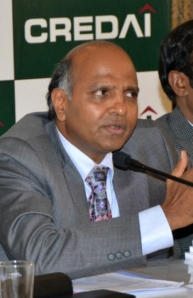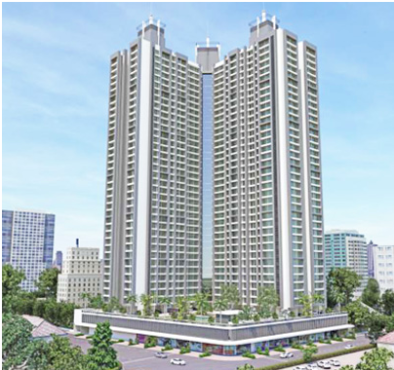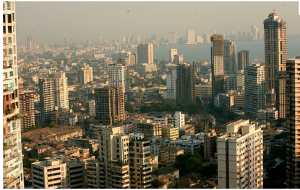
After living in his house for two years, 31-year-old Vincent Noronha realised that he needed a bigger house because he was planning to get married. So he began scouting for new property, but a few weeks of research made him change his mind. “The property rates being quoted were quite steep and beyond my budget even if I had sold my old house,” says the Thane-based assistant brand manager in a multinational company. There were other factors to contend with too. “My house is very conveniently located in terms of commute to work and the neighbours are very friendly,” adds Noronha. However, his problem for additional space remained. The only option seemed to be to tweak the current house.
Luckily for Noronha, the house where he lived had a high ceiling. “We had not renovated the place since purchasing it in 2010, so my parents and I decided to take advantage of the high ceiling and add a slab to the rooms to create another room,” he says.
Since the developer had already approved the plan while selling the property to them, all that Noronha had to do was take permission from his housing society for the planned structural changes. “We had to spend nearly 3 lakh to add an extra room measuring around 200 sq ft. It took us about three months to do so,” he says.
Like Noronha, many homeowners often discover that they need more space. Remodelling can help them expand their current house. However, if it’s an old house, it may need extensive modification, which could be complicated, expensive and time-consuming. The effort may not compensate for a cramped space, congested locality or bad neighbours. Under these circumstances, swapping houses could be a more sensible option and it could also allow you to enjoy better amenities. However, migrating to a new location may not always be a cost-effective option, and in some cases, you may have to sacrifice moving from a centrally located area to the suburbs. The decision to move or modify is a critical one, because a misstep could cost you a significant sum of money and a lot of your time.
EVALUATE YOUR NEEDS
A house is not just an investment; there’s an emotional attachment too. So, while earning profit by selling your house is a major factor in decision-making, other considerations also carry weight. The most important one is the quality of life, neighbourhood and the location. Here’s how to determine whether you should change addresses.
Is it time to move?
Many young couples buy their first house based on what they can afford at that time. However, as the family expands, the cosy house seems to be cramped. This is the most common reason for people to upgrade to a bigger house. In a situation like this, relocating is probably a better option as a renovation project has its own limitations in terms of adding space to the house. This would again be a financially beneficial decision after your professional life ends and the children move out (see When downsizing makes sense).
Is it the house?
If you do not like the floor plan of your house, there may be little you can do to change it through renovation, which may either be too expensive or not feasible at all. For instance, you can’t change the location of the wet areas, such as bathrooms and sinks. Some houses may also have restrictions in terms of the already approved plans and may require new permissions from the housing society or the local building authorities. Moving to a new house may work out to be more costeffective in this case.
Is it the location?
You may need to move to a new location for a specific reason, such as a change in job. When young couples choose their first house, their top priority is to look for one in an area close to the office. However, a few years later, the pressing need is a good school in the neighbourhood. Whatever may be prompting your decision to shift, calculate how long you will need to stay there. If it’s not a long period, renting a house for some time while retaining your old property, and earning rental income from it, may be a better option.
Is it the money?
The price of your house may have escalated more than in most other locations due to a major infrastructural development, say, an airport or a big hospital. You may be able to get a good price for it, which may enable you to buy a comfortable house in another location that is also suited to your needs. This could also be a feasible option for those facing a financial constraint since it allows you to not only tide over your financial problems but also buy a new house, even if you have to compromise a bit in terms of location or size.
Is it a lifestyle choice?
One thing that makes housing projects built in the past few years more appealing is the common facilities they offer. This can be as basic as a lift, to more aspirational ones like a swimming pool, which you may not be able to access easily in an older housing society. If the quality of life matters more to you, shifting to a swanky society may be more to your liking.
Calculate the cost
Don’t be pushed into a move by emotional reasons. After all, relocating involves hard cash too. So, compute how much it will actually cost you to transfer. The first cost will be the one associated with selling your current house. This could include the fees for professionals like a property broker or a lawyer. You may also have to spend money in preparing your house, such as repainting it, for sale and making it more attractive for prospective buyers. Then there are one-time expenses for the new house, such as registering the property, which could cost you up to 10% of the property’s value, stamp duty, and fitting a new electricity meter. In case of a resale property, there may also be costs incurred in transferring the title of the property, also known as conveyance.
Other than the home loan you may have to take, there will be additional costs to bear. “Since most homes are bought through home loans, lenders prefer if you also take an insurance policy to cover the loan. This means having to pay the premium for the policy,” says Ramesh Nair, managing director (West), Jones Lang LaSalle India.
Also, if you have moved to a bigger house, you may need to buy extra furniture and furnishings. You should also be prepared to pay a higher maintenance charge for the better common facilities that you will enjoy. “Maintenance charge and annual property tax are some of the costs that most buyers do not factor in prior to a purchase. In a new high-end construction, a lot of facilities, such as swimming pools, gymnasium and landscaped garden, involve a one-time additional cost,” adds Nair.
The expenses incurred during the initial period of a property transaction can amount to as much as 10-12% of the overall cost of the property.
Before you move
Choosing a new location is not easy. “You may have the funds to shift to a more spacious house, but you should first ascertain whether the new place will be more comfortable in terms of travelling to your place of work, the market or your child’s school,” says Ganesh Vasudevan, CEO of Chennai-based Indiaproperty.com. You need to keep such intangible factors in mind when you shift. A change in location may also mean an impact on the quality of utility services you are used to. “A new location may result in a change in the municipal limits or utility service providers, which could affect the quality of services that you have been consistently receiving. For instance, many localities have the problem of load shedding while some don’t,” adds Vasudevan.
From a purely financial aspect, you should consider the future capital growth potential of the area that you reside in compared with the area you may relocate to. This could influence your final decision.
However, don’t shift simply because you do not want to spend time and money on a problem that has occurred in the house. This is because a potential buyer will also look at the problem and the resale value of your apartment will go down. In such a case, overhauling the house could be more financially viable.
IS RENOVATION A BETTER IDEA?
Remodelling a house can be a great opportunity to not only keep what you want, but also add value and years to it. If you manage your costs well, a renovation project will be a more valuable investment than the upfront cost of the project itself. You get what you want: The biggest advantage of a renovation is that you do not have to choose between four or five template houses that a builder shows you. You have complete control over the project and can decide when to start, who to hire, the colour of your walls and the design of your wardrobes. Neither do you have to worry about an unfamiliar neighbourhood. However, rewarding as it may be, a major renovation is not an instant one and requires a lot of time and patience, apart from the money. The need for renovation: If you had bought your house 8-10 years ago, it’s probably time to spruce it up. How much you need to spend will depend on the condition of the house. It will be higher if you have a major problem like seepage or corroded plumbing as this may require not just fixing the problem but also spending money on accompanying modifications like the treatment of walls or flooring.
According to market experts, the average lifespan of a modern residential building is 60-75 years, depending on the quality of construction and climatic condition. A house needs to be renovated every 8-10 years, though a fresh coat of paint should be applied every 5-6 years. Waterproofing and plastering is required every 10-12 years. The cost of renovation: The cost will depend on the extent of repairs required, the age of the property and the kind of materials you use. The level of customisation that you seek will also have a bearing on the cost. For instance, a modular kitchen which can be fitted with units of standard sizes will cost less than the one that requires odd-sized ones.
Another important aspect that needs to be taken into account is time management. A full-fledged renovation project can last 2-6 months. If you are planning to shift to an alternate location till the house is refurbished, you will also need to factor in the additional rental costs for the time period, the brokerage and the deposit money.
Choosing the right person for the job:
Other than the quality of work, your choice of contractor will also determine the financial and emotional stress, so it is important that you research before you finalise who will redo the house. It is important to take in writing the break-up of various costs, the kind of work he will do and the time frame in the budget that he has quoted. This will help you determine if you need to give the entire project to him or choose several contractors for various jobs in the house. You should also check his past references and the work he has done. This will give you an idea about the quality of his work. Many contractors do several jobs at the same time and leave the task of renovation to foremen. So, you should fix the time limit for completing the job and the penal action in case of delay.
When downsizing makes sense
For most of us, relocating also means upgrading to a bigger house, but there may be situations when shifting to a smaller house may be more beneficial.
When N Pattabhi Ramiah received his retirement corpus a few years ago, he thought of investing it in a new house. “My earlier house was fetching me around 60 lakh. So, I decided to pool in 10 lakh from my retirement corpus and move to a bigger 2-bhk house at Andheri in Mumbai,” he says. However, for Pattabhi (66) and his wife N Giribala (63), the move was just the beginning of their troubles. “The monthly maintenance charge, 6,000, is twice what I used to pay earlier. I hadn’t taken this into account while buying the house, and now it has become a bit difficult to pay. Also, I don’t may not have to worry about any repair work right now, but eventually, this will be a monetary concern too,” he adds.
A bigger house may not always be advantageous and could even be financially detrimental for people whose income has shrunk.
How the cost escalates
The monthly maintenance charge of a house is based on its area and ranges from 3-20 per sq ft, based on the amenities and the locality. So, you will have to pay more for a larger house.
Other than this, you will need to pay property tax on the value of the house, which depends on factors like the age of the building and its location. Usually, for residential premises, the tax is 75-80% of the rateable value, which is based on its fair annual rent. A standard deduction of 10% is allowed on this value. Then there are taxes like the water tax levied by the local municipal authorities, which is again based on the rateable value.
If you plan to insure your home, the premium will depend on the size of the house, among other things. So again, a larger house, keeping all other things the same, will mean a higher premium. A bigger house will require more furnishing, furniture and daily care too. Obviously, it would also require a larger corpus to be kept aside for repairs and longterm upkeep.
Benefit of downgrading
Downsizing to a smaller home may be inconvenient for those who have been living in a bigger property for a long time. However, the financial benefits could outweigh the discomfort in the long term. Says Pankaj Kapoor, MD of Liases Foras: “You would be able to boost your savings corpus substantially by selling the bigger house and shifting to a smaller one.”
Are you ready to make a move?
The decision to remodel or shift will depend on the option that is better in terms of time and money.
REASONS TO MOVE
• The size of your family has changed.• You want to move to an area that has better common facilities, such as clubs.
• There are better schools in the area.
• You want to reduce the commuting time.
• Remodelling will be time-consuming.
• You have received a windfall and can afford a better home now.
COST OF MOVING
• Getting a house ready to sell.
• Real estate agent’s fee.
• Taking a bridge loan to fund the difference in new and old property.
• Possible increase in property taxes.
• Increase in maintenance charges.
• Stamp duty and registration costs.

EASONS TO RENOVATE
• You will get exactly the home you want.• Remodelling can be a good investment.• You don’t want to take another home loan.
LIMITS OF RENOVATION
• You can’t alter existing horizontal or vertical dimensions, or change location of wet areas.
• You can’t remove load bearing walls or load the existing structure.
WHEN TO RENOVATE
60-75 years
is the average life span of a modern residential building.
8-10 years
is the time after which a home needs to be renovated.



HOW TO FUND A RENOVATION PROJECT
If you are the owner or coowner of the house, you can opt for a top-up loan in case you are still paying a home loan, or go for a home improvement loan.
Requirements
• Banks usually do not give renovation loans for properties that are older than 35 years.• The maximum age, plus repayment period, should not be beyond retirement in case of salaried persons, and 65 years in case of others.• A quotation must first be obtained from a civil contractor, engineer or architect, and submitted to the lender. Only after its technical department has approved the quotation will the loan be disbursed.
How much can you get?
• A salaried person can get up to two times his gross annual income.
• Others (professionals, selfemployed, etc) can get up to three times their net annual income.
What’s the cost?
• Interest rate: 13-14%
• Margin: 25% of the project cost
• Repayment period: Up to 10 years
• Processing charges: 0.5%
Tax benefits
• Under Section 24, the interest paid on the home improvement loan is tax deductible up to 30,000 a year, subject to a limit of 1.5 lakh on the interest paid on all home loans. No deduction is available for the principal portion of repayment.





















